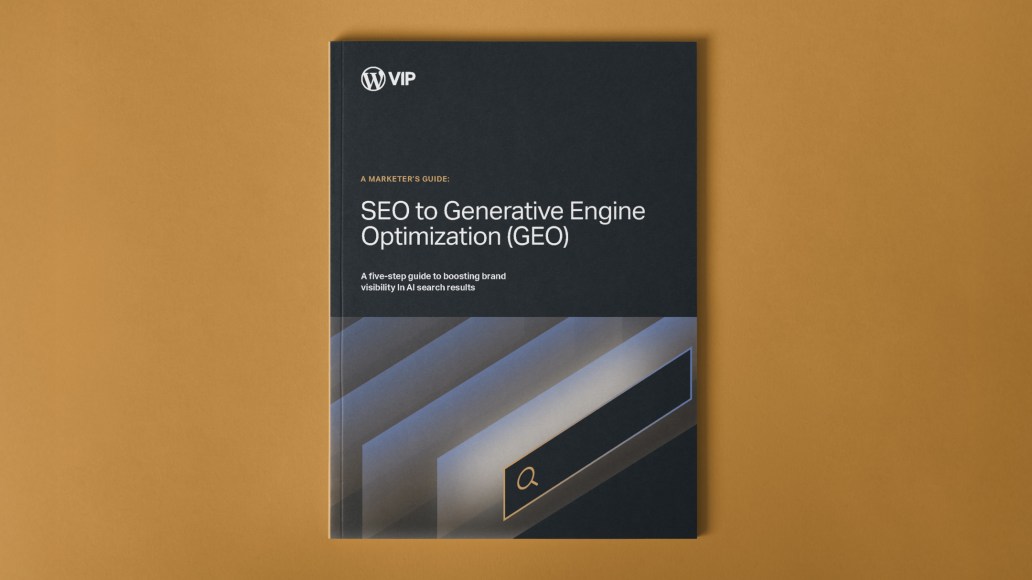The zero-click customer looks just like your traditional target buyer.
They may indicate purchase intent based on what they’re researching online.
All the blog posts, ebooks, and buyer’s guides you’ve developed could help them make the right decision.
The question is whether they’ll see any of it. This is why enterprises are rushing to get a handle on answer engine optimization (AEO).
Between January and May of this year, search traffic on AI-powered platforms has risen 527%. But that might only translate to a 1% increase in referral traffic from large language models (LLMs).
The information AI search tools are providing may be enough to satisfy prospects who might have clicked through a traditional search result on Google.
This means a prospect might compile their initial list of prospective vendors, perform cross-comparisons, and even finalize details around pricing with AI as the primary point of contact.
As the zero-click customer finds what they need and avoids filling out online forms or tapping a button to schedule a demo, the ability to influence their next step begins to feel just out of arm’s reach.
The role of business websites in the answer engine era
“Providers will need to evolve the role of their website from a traffic generation and lead harvesting engine to an information syndication engine.”
— John Buten, Principal Analyst, Forrester
“With fewer, better-informed prospects coming to their site and converting at higher rates, providers looking to grow will need to reinvest in the fundamentals — developing their reputation among buyers prior to a formal purchasing process.”
It’s not only a matter of optimizing content for AI tools like ChatGPT, Perplexity, and Gemini. Enterprise marketing teams also have to deepen their connections with the primary sources LLMs draw upon. These include user-generated community forums like Reddit and Quora, as well as niche publications and even Wikipedia.
Business websites are also still critical sources for LLMs, of course. They just have to be weighted as valuable enough to remain part of the mix that drives AI-powered search results.
You still need to produce content that establishes your business as a trustworthy authority in the sector you’re serving. Instead of that authority driving a click-through, however, you’re now focused on ensuring your content is being cited in the answers zero-click customers consume.
How important is SEO for business sites that want to be cited in answer engine results?
Search engine optimization (SEO) has been the primary fuel for organic search traffic on Google for decades. It will continue to be an important practice, given that recent data shows Google still holds nearly 90% market share. Google has said SEO will get sites ranked in AI overviews.
Even as answer engine tools grow in popularity, the LLMs and inner workings behind them remain proprietary. This makes optimizing your content to be cited — which is sometimes called answer engine optimizatoin (AEO), LLMO, generative engine optimization (GEO), or simply AI search optimization — more of an art than a science.
Here’s what we know now about the key differences between SEO and AEO, with examples of how to approach each type of optimization:
| Aspect | SEO | AEO |
|---|---|---|
| Audience | Search engines (for users) | AI bots (for users via chat interface) |
| Content structure | Keyword-rich, long-form, hierarchical | Concise, direct, context-rich |
| Technical focus | Crawlability, indexing, ranking signals | Clarity, structure, factual accuracy |
| Visibility | SERP rankings | Inclusion in AI-generated responses |
| Backlinks | Important for ranking | Less relevant for AI extraction |
| Updates | Important, but search engines may lag | Critical, as AI may use cached data |
| Primary goal | Higher search ranking | Accurate AI answers/citations |
| Content style | Keyword-focused, in-depth | Clear, direct, factual |
| Structured data | Schema.org, sitemaps | Schema, FAQs, tables, clear markup |
Though adapting in this environment can feel a bit like building a parachute while falling out of an airplane, these are some of the areas to explore and experiment:
1. Use keyword research to think through conversational prompts
AI search is based on a conversational interface where buyers are asking very detailed questions, in full sentences. This means getting cited depends on having content that supports all the contextual details that get included in a prompt.
Let’s say your firm is offering a B2B SaaS tool that streamlines contract management, aimed at the legal profession. Keywords like “legal SaaS” or “legal contract management software ” might have once been enough to work from an SEO perspective. But if your target audience is using answer engines, they might enter a prompt like this:
What’s a good contact management tool for a mid-sized family law firm with little experience in using advanced technology that costs less than $100 per user and offers a free/low-cost trial version that’s based in the U.S. and has gotten good reviews from actual legal professionals?
Notice what this prompt includes:
- Target audience, or what other businesses would call their ideal customer profile (ICP)
- Their specific pain point (a less-than-tech-savvy employee base)
- Location
- Budget
- The desire for social proof
Developing marketing assets can begin with keywords, but should become much more specific. A blog post could use H2s and H3s to answer each of the sub-questions contained in the original prompt, which would become snippets for LLMs to gather.
2. Use analytics to identify what’s bringing AI bot traffic to your site
Even if only a small percentage of people click through from an AI-powered search result to your site, you should aim to understand what topics drove them there.
This is another good reason to make sure you’ve got a streamlined approach to analyzing all traffic sources. The Google Search Console Parse.ly integration, for instance, saves you from having to log into separate applications and provides greater visibility into what’s happening from a search traffic perspective. From there, you can put more time into optimizing for AI search.
3. Assist AI with your own summaries
Marketing teams tend to be highly skilled in winnowing down content so the most important details stand out. You can take a similar approach in helping both buyers and AI searchbots see at a glance the value your content is offering. Examples include:
- TL;DR summaries
- A table of contents
- Sidebars where information or data can easily be lifted out
These summaries are just the start. You also need to consider site schema, which a modern CMS supports. Modular content is the foundation for AI readiness because it’s easier to reuse, discover, and scale.
Most importantly, your content needs to be publicly available to LLMs. There have been longstanding debates on whether or not to “gate” enterprise content. Unless you’re confident you can capture leads based on distributing the content through your owned, direct channels, lower the gates.
4. Demonstrate your authority
Enterprise brands may enjoy a strong reputation among their installed base, but LLMs determine credibility on a search-by-search basis. This is where proprietary data plays a strong role — whether it’s a survey or simply information on product usage you publish online.
In addition:
- Share your content with relevant journalists: achieving earned media means you’re getting cited by the kind of publishers that, in turn, get cited by answer engines.
- Contribute to discussions on sites like Quora, Reddit, and LinkedIn.
- Make sure you’re weaving authority directly into the way you present marketing content (expanded author bios with career history, educational background, and other proof points.).
This is not unlike the criteria Google’s human reviewers have been using to judge content quality. Experience, expertise, authority, and trust (EEAT) should be evident on every page. As Search Engine Journal reported, Google has updated its guidelines to avoid attempts to fake EEAT. Never take your reputation for granted, or it might get buried behind an AI searchbot result.
5. Publish on a site where you can scale content efforts to impress LLMs
The greater the breadth and depth of your content, the more likely it will make it into an AI search citation. As a result, your marketing team should find it easier than ever to develop case studies, competitor takeouts, buyer’s guides, and original search. A CMS that streamlines publishing workflows and uses AI to assist in content creation is no longer a nice-to-have — it’s essential.
The right CMS allows enterprises to work with structured content that helps teams move faster and reduces dependence on quick-fix AI “bolt-ons.” This is a pillar of AI readiness.
AI search tools will not scrape your site if it’s frequently down or pages take too long to load, though. That’s why your CMS needs to deliver high-performance speed, stability, and security at all times.
Don’t mistake the zero-click customer as having zero interest in the information you can offer them. Just recognize AI as the go-between it’s quickly becoming, or simply as the new first point of contact in a new kind of customer journey.
Frequently asked questions
What is answer engine optimization (AEO)?
AEO is a strategy for tailoring content to the conversational-style interfaces of AI search tools such as ChatGPT, Perplexity and Google’s AI Overviews. It aims to have content show up in the answer these tools provide rather than rank a web URL in a traditional search engine query.
What is a zero-click search?
A zero-click search refers to the process whereby AI searches provide answers, overviews, or summaries that contain all the information a person needs without requiring them to click on additional sites for more detail. These answers could contain product details, pricing, reviews, market research, and more.
How is AEO different from SEO?
SEO techniques are intended to help sites get included in search engine rankings based on using keywords and keyword phrases that reflect common terms people put into queries. AEO is focused on turning website content into source data for the large language models (LLMs) that fuel AI search tools.
How to optimize for answer engines?
Develop content based on common questions your target audience is likely posing to tools like ChatGPT. Use analytics to determine where AI search tools are already sending traffic to prioritize your efforts. Create your own summaries LLMs can easily scrape, and demonstrate authority with original research and insights.
Author

Shane Schick
Founder, 360 Magazine
Shane Schick is a longtime technology journalist serving business leaders ranging from CIOs and CMOs to CEOs. His work has appeared in Yahoo Finance, the Globe & Mail and many other publications. Shane is currently the founder of a customer experience design publication called 360 Magazine. He lives in Toronto.




